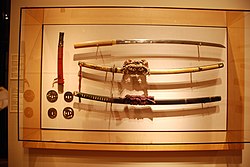Koshirae
Koshirae ( Jap. 拵 ) is called the entire wig base of a Japanese sword or knife .
description
The outfit includes the lacquered sword scabbard ( Saya ), coating and winding of the handle ( called tsuka , usually covered with ray or (rarely) shark skin and wrapped with colored silk ribbons or leather straps), as well as the often richly decorated guard ( tsuba ) and metal ones Fittings on the handle and Saya (KODOGU). Typical Japanese edged weapons with koshirae mounts are the long sword called katana , the older long sword tachi , the short sword wakizashi and the combat knife called tantō . For many swords the all-purpose knife Kogatana and the sword needle Kogai belonged to the Koshirae ; These tools were pushed through openings in the tsuba or stowed in 'compartments' on the side of the saya .
Koshirae served not only functional, but also aesthetic purposes, with the family coat of arms ( Mon ) often being used as decoration and identification.
Types of Koshirae
There were different mounts for the different swords.
Tachi-Koshirae
- Kazari-Tachi (飾 太 刀) - An elaborately decorated, ceremonial mount that was worn at the imperial court during the Heian period .
- Hoso-Tachi (細 太 刀) - Also worn at the imperial court, but simpler than Kazari-Tachi.
- Eifu-Tachi (衛 府 太 刀) or Kenukigata-Tachi (毛 抜 形 太 刀) - Originally for the Tachi of the palace guards in Heian-kyō and therefore also suitable for combat. The handle had a decorative opening.
- Hyôgo-Kusari-Tachi (兵 庫 鎖 太 刀) - The scabbard of this Tachi has two chains as a pendant. Mostly ceremonial use.
- Kurourushi-Tachi (黒 漆 太 刀) - Simple, black lacquered combat mount.
- Itomaki-no-Tachi (糸 巻 太 刀) - Tachi with handle wrapping.
Katana Koshirae
- Uchigatana (打 刀) - The typical katana, which was carried through the belt with the edge pointing upwards.
- Handachi (半 太 刀) - Early Uchigatana mounts were kept quite simple, the Handachi mount imitated the more splendid Tachi.
- Banzashi-Daishô (番 差 大小) or Tojôzashi-Daishô (登 城 差 大小) - Strictly regulated mounting for the Daishō , which was worn by the Samurai of the fortress of Edo.
Wakizashi and Tantō-Koshirae
The style of the mounts for wakizashi and tanto often corresponded to the long sword, but pairs of swords with different mounts were also worn.
- Aikuchi (合口 or 匕首) - mounting without tsuba , the handle and the scabbard mouth close flush; mostly without handle wrapping.
- Hamidashi (喰 出 し) - The tsuba is only slightly larger in diameter than the sheath ; often without handle wrapping.
- Banzashi-Daishô (番 差 大小) or Tojôzashi-Daishô (登 城 差 大小) - The equivalent of the above. Katana Koshirae .
Other mounts
- Shirasaya (白 鞘) - scabbard and handle made of magnolia wood, which are used to store the blade. The separate storage of the blade and combat mount is necessary because the blade needs dryness to prevent rust, but the paint on the combat mount needs a certain amount of moisture to prevent cracks.
- Shikomizue (仕 込 み 杖) or Jotō (杖 刀) - The Japanese version of a stick sword .
literature
- CU Guido Schiller, S. Alexander Takeuchi: Koshirae: Nihon Tôken Gaisô. The Mountings of Japanese Swords. In: Macao Museum of Art: History of Steel in Eastern Asia. Retrieved September 19, 2012 .
- Leon Kapp, Hiroko Kapp, Yoshindo Yoshihara: The Craft of the Japanese Sword . Kodansha International, Tokyo et al. 1987, ISBN 0-87011-798-X .
- Nobuo Ogasawara: Japanese Swords . 9th edition. Hoikusha Publishing Co. Ltd., Osaka 1984, ISBN 4-586-54022-2 , ( Color books 22).
- Kanzan Satō: The Japanese Sword . Translated and adapted by Joe Earle. Kodansha International et al., Tokyo et al. 1983, ISBN 0-87011-562-6 .
- John M. Yumoto: The Samurai Sword. A handbook . 30.print. Charles E. Tuttle Company, Rutland VT 1992, ISBN 0-8048-0509-1 .
Web links
- History of the Development of Koshirae (English)
- Description of Koshirae ( Memento from May 24, 2015 in the Internet Archive )

